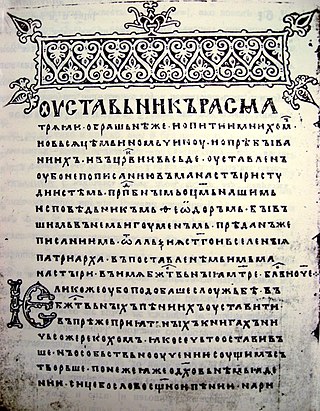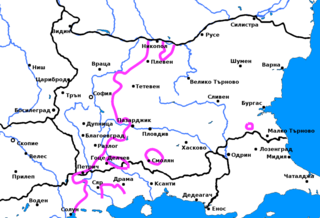Related Research Articles

Old Church Slavonic or Old Slavonic is the first Slavic literary language.

The Ser-Drama-Lagadin-Nevrokop dialect is a dialect currently treated both in the contexts of the southeastern group of Bulgarian dialects and the southeastern subgroup of dialects of the Macedonian. Prior to the codification of standard Macedonian in 1945, the dialects of Macedonia were classified as Bulgarian. The dialect is dynamic and is well known for the shortening of the words, and also characterised by the excessive use of for the Proto-Slavic yat even in cases where standard Bulgarian has, a feature which is typical for a number of dialects spoken in southern and southwestern Bulgaria . The Ser-Drama-Lagadin-Nevrokop dialect is closely related to the neighbouring dialects. It is closer to all Eastern Bulgarian dialects than to all Western. Macedonian shares much less features with the dialect than it does with the Maleševo-Pirin dialect of Macedonian and Bulgarian. Some Bulgarian dialects are more similar to Macedonian than the Ser-Nevrokop dialect, the Samokov dialect shares more features with Macedonian than both the Ser-Nevrokop and the Pirin-Malasevo dialects do, even though it is not considered a Macedonian dialect, the most of the western Bulgarian dialects and the Smolyan dialect share more similarities with Macedonian than the Ser dialect does. The Samokov dialect, most remarkably, shares with Macedonian and the Maleševo-Pirin dialect—the "to be" verb for future tense—"ke", which in contrast is "shte" in the Ser-Nevrokop dialect and in the Bulgarian language. The Yat border passes through the Maleševo-Pirin dialect and divides it on such a way that in the northern area of the dialect the yat is pronounced "e" and in the south—"ya". In the Ser-Nevrokop dialect the yat is pronounced in most places "ya", therefore the city of Serres, after which the dialect is named, is called "Syar" by the locals, as opposed to "Ser" in Macedonian. The first person singular is as in Bulgarian, ending with "a" or "am" as opposed to the constant "am" in Macedonian and the Bulgarian Smolyan dialect. The words for man -"m'zh" and for a dream "s'n" are as in Bulgarian, unlike the Macedonian "mazh" and "son". The words for night and tear—"nosht" and "s'lza" are as the Bulgarian, unlike the Macedonian "nok" and "solza".

The Northwestern Bulgarian dialects are two closely related dialects of the Bulgarian language, which are located west of the yat boundary and thus are part of the Western Bulgarian dialects. The range of the dialects includes most of northwestern Bulgaria, to the west of the line between Nikopol, Pleven and Mezdra and to the north of the line between Vratsa and Belogradchik. They bear strong resemblance to their neighbouring Eastern Bulgarian dialects and with some exceptions, mainly the pronunciation of yat, have the same phonological and morphological features as the neighbouring subdialects of the Eastern Bulgarian Central Balkan dialect.

The Vidin-Lom dialect is a Bulgarian dialect spoken in the regions of Vidin and Lom and partially in the regions of Berkovitsa and Montana in northwestern Bulgaria. The dialect is part of the Northwestern Bulgarian dialects. The most significant feature of the dialect, as in all Western Bulgarian dialects, is the pronunciation of Old Church Slavonic ѣ (yat) only as instead of formal and Eastern Bulgarian я/е (/) – бел/бели instead of бял/бели.

The Central Balkan dialect is a Bulgarian dialect that is part of the Balkan group of the Eastern Bulgarian dialects. Its range includes most of north-central Bulgaria, as well as the regions of Karlovo, Kazanlak and Plovdiv in southern Bulgaria, all the way down to the northernmost ridges of the Rhodopes. As a result of the mass population movements that affected eastern Bulgaria during the 19th and the beginning of the 20th century, the Central Balkan dialect is now spoken also in vast areas of northeastern Bulgaria. The most significant feature of the dialect is the pronunciation of Old Church Slavonic ѣ (yat) as or, depending on the character of the following syllable. The Central Balkan dialect lies at the foundation of formal Bulgarian. However, it is not identical to the standard language because many of its features derive from the Western Bulgarian dialects, including the Macedonian dialects, or are a compromise between Eastern and Western standard. The Central Balkan dialect includes a number of subdialects, e.g. Troyan, Lovech, Gabrovo, Karlovo, Kalofer, Tryavna, etc. which share many common features and yet have some differences.
The Pirdop dialect is a Bulgarian dialect, which is part of the Balkan group of the Eastern Bulgarian dialects. Its range includes the towns of Pirdop, Zlatitsa and Koprivshtitsa, as well as several neighbouring villages. The most significant feature of the dialect, as in all Balkan dialects, is the pronunciation of Old Church Slavonic ѣ (yat) as or, depending on the character of the following syllable. However, the Pirdop dialect also features a number of characteristics which bring it closer to the neighbouring Western Bulgarian dialects, and especially to the Botevgrad dialect and which, in turn, separate it from the rest of the Balkan dialects.
The Panagyurishte dialect is a Bulgarian dialect, which is part of the Balkan group of the Eastern Bulgarian dialects. Its range includes the town of Panagyurishte, as well as a number of neighbouring villages. The most significant feature of the dialect, as in all Balkan dialects, is the pronunciation of Old Church Slavonic ѣ (yat) as or, depending on the character of the following syllable.
The Razlog dialect is a Bulgarian dialect, member of the Rup dialects. Its range includes the valley of Razlog in southwestern Bulgaria and its immediate neighbours are the Rup Serres-Nevrokop dialect to the south, the Babyak dialect to the east, the Samokov and Ihtiman dialects to the north and the Blagoevgrad-Petrich dialect to the west. It shares a number of phonological characteristics with both the Rup and the Southwestern dialects. This is the dialect through which the Bulgarian language became known to modern science, because in 1822 the creator of the modern Serbian language Vuk Karadžić published in Vienna Dodatak k sankpeterburgskim sravnitelnim rijechnicima sviju jezika i narijechija s osobitom ogledom Bugarskog jezika ;("An addition to the St. Petersburg comparative dictionaries of all languages and dialects with a particular sample of the Bulgarian language"), in which are placed 273 words, a short grammar, 27 folk songs and 2 chapters of the gospel, which he wrote and said to him pravi bugarin iz Razloga;("a real Bulgarian from Razlog").
The Teteven dialect is a Bulgarian dialect, which is part of the Balkan group of the Eastern Bulgarian dialects. It is spoken in the town of Teteven and several neighbouring villages and is almost completely surrounded by the Central Balkan dialect, except on the west where it borders on the Western Bulgarian Botevgrad dialect. The most significant feature of the dialect, as in all Balkan dialects, is the pronunciation of Old Church Slavonic ѣ (yat) as or, depending on the character of the following syllable.

The Southwestern Bulgarian dialects are a group of Bulgarian dialects which are located west of the yat boundary and are part of the Western Bulgarian dialects. The range of the Southwestern dialects on the territory of Bulgaria includes most of west central and southwestern Bulgaria. The Southwestern dialects border on the Northwestern dialects to the north, the Transitional dialects to the northwest and the Balkan dialects and the Rup dialects to the northeast and southeast, respectively. If the Macedonian language is regarded as a third literary form of Modern Bulgarian, then the Southwestern dialects extend west and southwest to include the Slavic dialects in Vardar Macedonia and the western half of Greek Macedonia. Should the Macedonian language be counted as a separate language, then the southernmost dialect of the group, the Blagoevgrad-Petrich or Pirin dialect, along with the corresponding variety on the Macedonian side of the border, the Maleshevo dialect, constitute a transitional dialect between Bulgarian and Macedonian. A defining characteristic of the Southwestern dialects is the gradual transition from one dialect to another, as well as to dialects which belong to other dialectal groups. For example, the Dupnitsa dialect is transitional to both the Samokov dialect and the Blagoevgrad-Petrich dialect, the Botevgrad dialect is transitional to the Eastern Bulgarian Balkan dialects, and especially to the Pirdop dialect, etc. etc.
The Botevgrad dialect is a Bulgarian dialect, member of the Southwestern Bulgarian dialects, which is spoken in the region of Botevgrad and Etropole in northwestern Bulgaria. It is located on the yat boundary and is closely related to the Eastern Bulgarian Pirdop dialect.
The Ihtiman dialect is a Bulgarian dialect, member of the Southwestern Bulgarian dialects, which is spoken in the regions of Ihtiman, Kostenets and Septemvri in central western Bulgaria. It is transitional between the Botevgrad and Samokov dialect.
The Elin Pelin dialect is a Bulgarian dialect, member of the Southwestern Bulgarian dialects, which is spoken in the eastern part of the Sofia valley in central western Bulgaria. Its immediate neighbours are the Vratsa dialect to the north, the Botevgrad dialect to the east, the Sofia dialect to the west and the Samokov dialect to the south.
The Samokov dialect is a Bulgarian dialect, member of the Southwestern Bulgarian dialects, which is spoken in the region of Samokov in central western Bulgaria. Its immediate neighbours are the Sofia dialect and Elin Pelin dialect to the north, the Ihtiman dialect to the east, the Dupnitsa dialect to the west and the Razlog dialect to the south.
The Dupnitsa dialect is a Bulgarian dialect, member of the Southwestern Bulgarian dialects, which is spoken in the region of Dupnitsa in central western Bulgaria. It is transitional between the Samokov dialect to the east and the Blagoevgrad-Petrich dialect to the south.
The Kyustendil dialect is a Bulgarian dialect, member of the Southwestern Bulgarian dialects, which is spoken in the region of Kyustendil in central western Bulgaria. It borders on the Transitional dialects to the north, the Dupnitsa dialect to the east and the Blagoevgrad-Petrich dialect to the south. It is closely related to the Dupnitsa dialect.

The Transitional Bulgarian dialects are a group of Bulgarian dialects, whose speakers are located west of the yat boundary and are part of the Western Bulgarian dialects. As they have most of the typical characteristics of the North-Western Bulgarian dialects, they are sometimes classified as belonging to this subgroup under the name of Extreme North-Western dialects. On Bulgarian territory, the Transitional dialects occupy a narrow strip of land along the Bulgarian border with Serbia, including the regions of Tran, Breznik, Godech, Chiprovtsi and Belogradchik. They also cross the border to include the dialects or subdialects of the Bulgarian minority in the Western Outlands. The Transitional dialects are part of the Torlak dialectal group also spoken in southeastern Serbia and North Macedonia and are part of the gradual transition from Bulgarian to Serbian. The Bulgarian Transitional dialects and the Serbian Prizren-Timok dialects are loosely characterised by mixed, predominantly Serbian phonology and predominantly Bulgarian morphology. The features described here are characteristic only of the Transitional dialects within Bulgaria.
The Breznik dialect is a Bulgarian dialect, member of the Transitional dialects, which is spoken in the region of Graovo in central western Bulgaria. It borders on the Tran dialect to the west and north, the Kyustendil dialect to the south and the Sofia dialect to the northeast and features characteristics typical for the Southwestern Bulgarian dialects.
The Belogradchik dialect is a Bulgarian dialect, member of the Transitional dialects, which is spoken on the westernmost northern slopes of the Balkan mountains in northwestern Bulgaria. It borders on the Northwestern Byala Slatina-Pleven and Vidin-Lom dialect and north, the Sofia dialect to the southeast and the Serbian Torlak dialect to the southwest.
The Tran dialect is a Bulgarian dialect, member of the Transitional dialects, which is spoken in the regions of Tran and Godech in central western Bulgaria and in the Western Outlands. It borders on the Belogradchik dialect to the north, the Sofia dialect to the east and the Breznik dialect to the south.